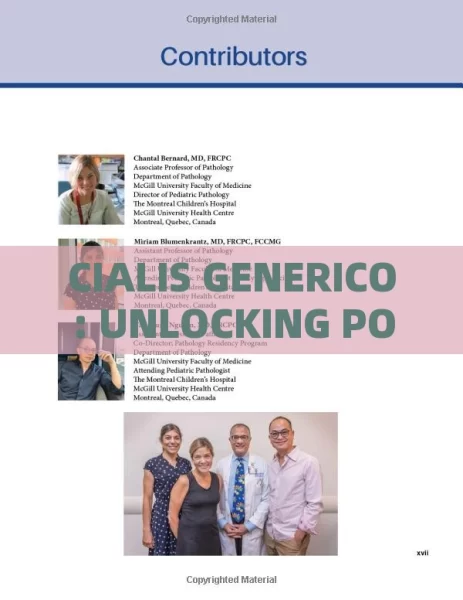CIALIS GENERICO: UNLOCKING POTENTIALTitle: Understanding the Impact of Cialis Generico on Modern Healthcare
Cialis generico, a topic of great significance, holds the key to numerous possibilities. In this article, we'll explore its various aspects, applications, and impacts. Cialis generico refers to the generic version of Cialis, a well-known medication. Its importance lies in providing an affordable alternative to the brand-name drug, making it accessible to a wider range of people.
Let's delve into the details. Cialis generico works by relaxing the blood vessels, increasing blood flow to the penis, and helping men achieve and maintain an erection. It is commonly used to treat erectile dysfunction, a condition that affects millions of men worldwide. According to recent studies, the prevalence of erectile dysfunction is increasing, highlighting the need for effective treatment options.
One of the key benefits of Cialis generico is its cost-effectiveness. Compared to the brand-name version, it offers a more affordable solution without compromising on quality or efficacy. This makes it an attractive option for those who may be concerned about the financial burden of medication.

To illustrate its effectiveness, let's consider a real-life case. Mr. Smith, a 55-year-old man, was struggling with erectile dysfunction. After consulting his doctor, he was prescribed Cialis generico. Within a few weeks, he noticed a significant improvement in his sexual function, and his confidence was restored.
In conclusion, Cialis generico plays a crucial role in the treatment of erectile dysfunction. Its affordability, effectiveness, and accessibility make it a valuable option for many men. However, it's important to consult a healthcare professional before starting any medication. They can provide personalized advice based on your specific needs and medical history.
Question: How does Cialis generico work?
Answer: Cialis generico works by relaxing the blood vessels, increasing blood flow to the penis, and helping men achieve and maintain an erection.
In the realm of healthcare, advancements in medical treatments continually reshape patient care and outcomes. One such innovation is the advent of generic versions of popular medications, which has significantly impacted access to healthcare. A prime example of this evolution is "Cialis generico," a term commonly used to refer to the generic versions of the brand-name drug Cialis, which is used to treat erectile dysfunction. This article delves into the importance of Cialis generico, its implications for patients and healthcare systems, and its role in modern medicine.
The introduction of generic drugs like Cialis generico is pivotal for several reasons. Primarily, it offers a more affordable alternative to branded medications, making essential treatments accessible to a broader segment of the population. According to the World Health Organization (WHO), generic medicines can reduce costs by up to 30-80%, enabling healthcare systems to allocate resources more efficiently. This affordability is critical in regions where healthcare budgets are limited, yet the need for effective treatments is high.
Cialis generico contains the same active ingredient as its brand-name counterpart, tadalafil, which helps relax blood vessels and improve blood flow. Studies have shown that generic drugs can be just as effective and safe as their branded equivalents. For instance, a study published in the New England Journal of Medicine found no significant difference in the efficacy between generic and brand-name drugs when treating various conditions, including erectile dysfunction. Such findings underscore the reliability of generic medications like Cialis generico.

The application of Cialis generico extends beyond cost-effectiveness. It also plays a crucial role in public health strategies aimed at combating chronic diseases. Erectile dysfunction is often a symptom of underlying health issues such as cardiovascular disease. By providing accessible treatment options like Cialis generico, healthcare providers can address these symptoms effectively while encouraging patients to seek further evaluation and management of potential chronic conditions.
A case in point is the implementation of Cialis generico in low-income countries. In regions where economic constraints limit access to expensive branded medications, the availability of a cheaper alternative has transformed the lives of countless individuals. For example, in India, the launch of generic versions of erectile dysfunction medications has significantly increased the number of men seeking treatment, demonstrating how accessibility can lead to better health outcomes.
Despite the clear benefits, there are common misconceptions about generic drugs that need addressing. One prevalent myth is that generic drugs are inferior to brand-name versions. However, regulatory agencies like the Food and Drug Administration (FDA) ensure that generic drugs meet the same rigorous standards of quality, safety, and efficacy as their branded counterparts before they reach the market.
Looking ahead, the future of Cialis generico and similar generic medications appears promising. As research continues to evolve and pharmaceutical technologies advance, we can expect even more effective and affordable generic treatments to emerge. This trend will likely expand access to healthcare and improve patient outcomes globally.
In conclusion, Cialis generico represents a significant development in modern healthcare, offering an affordable and effective solution for those dealing with erectile dysfunction. Its role in enhancing access to treatment, supporting public health initiatives, and debunking misconceptions about generic drugs cannot be overstated. As we move forward, embracing generic medications like Cialis generico will be crucial in our efforts to create a more inclusive and effective healthcare system.
For those considering treatment options, consulting with a healthcare provider to discuss the benefits of generic alternatives like Cialis generico is highly recommended. With ongoing advancements and increasing accessibility, the future holds promise for improved health and well-being worldwide.
Cialis